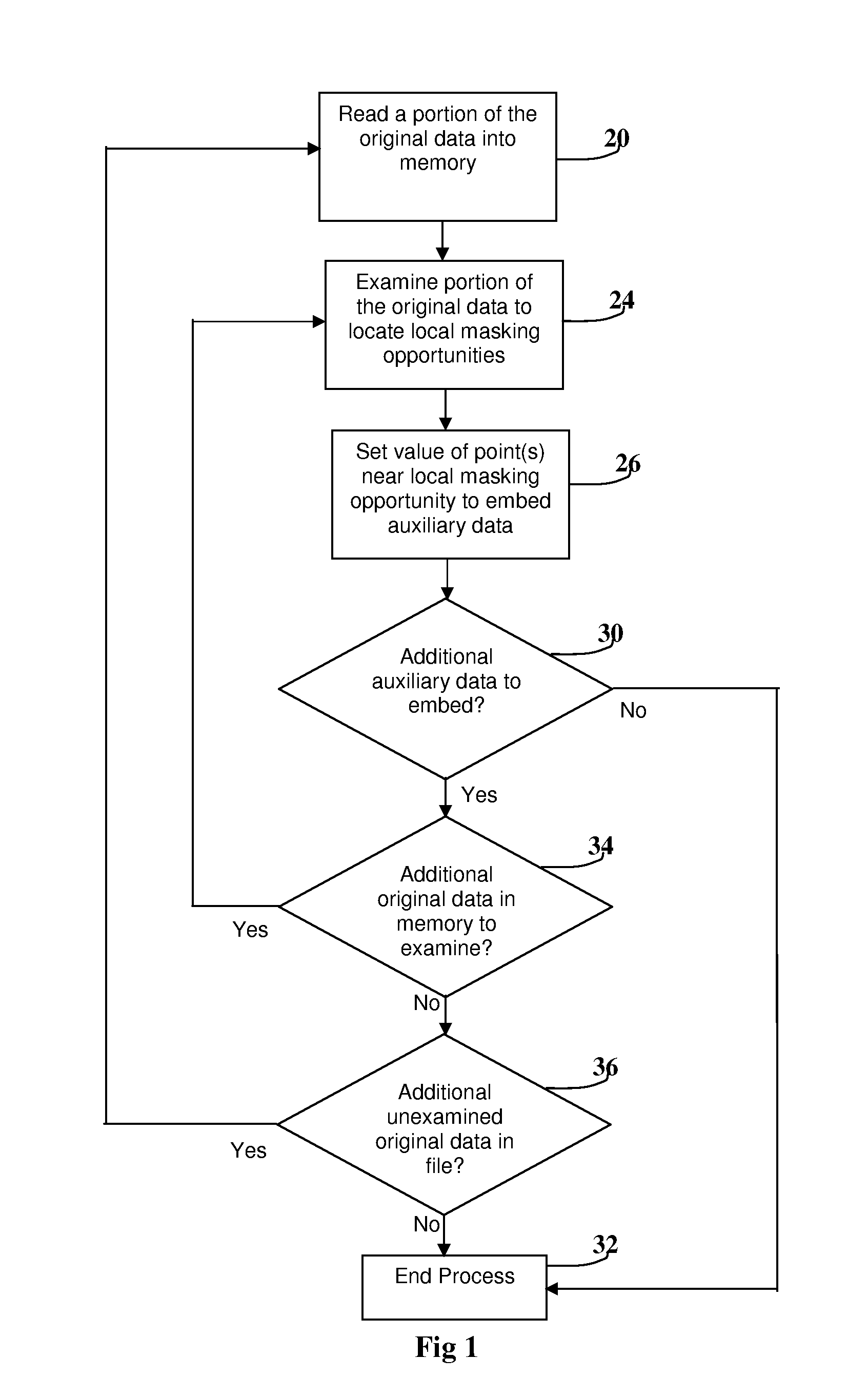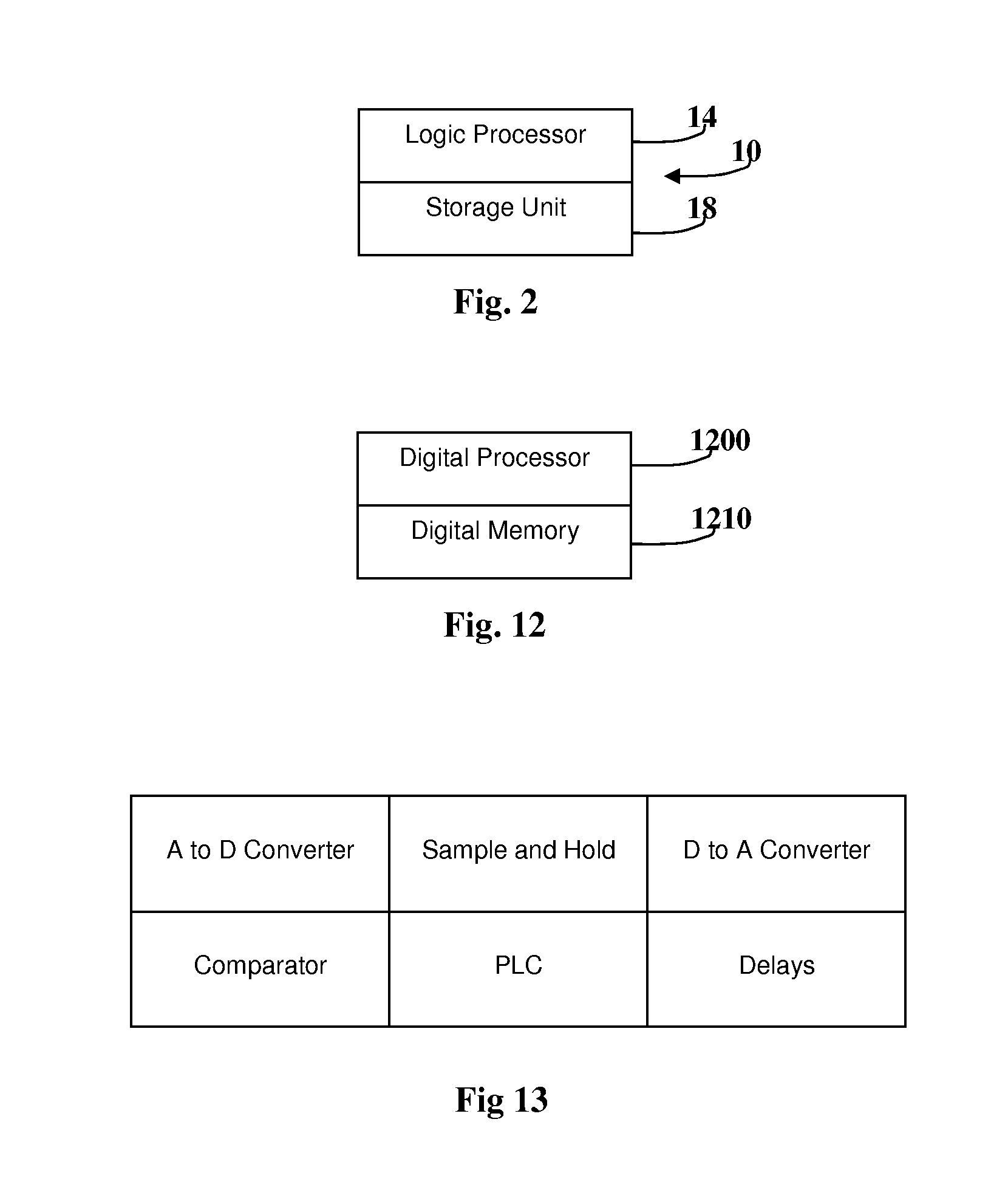Method and Apparatus for Embedding Auxiliary Information Within Original Data
a technology of auxiliary information and original data, applied in the field of signal processing, can solve the problems of difficult detection and removal of unauthorized copies, difficult enforcement of copyright laws, and loss of millions of dollars annually, and achieve the effects of less expensive, easy detection and removal, and high efficiency
- Summary
- Abstract
- Description
- Claims
- Application Information
AI Technical Summary
Benefits of technology
Problems solved by technology
Method used
Image
Examples
embodiment 1
[0072] The first preferred embodiment is based upon hiding the auxiliary information in large peaks within the original data. In this embodiment, the auxiliary information is preferably broken into N bit words, with synchronization data placed between the words for better error recovery. The auxiliary information does not need to include sync pulses between the words if robustness to noise or modified files is not needed.
[0073]FIG. 4 conceptually shows that the first embodiment detects a peak or local maximum and sets the value of the subsequent point in relation to the peak to indicate the value of the embedded bit.
[0074]FIG. 5 includes the pseudocode in the form of a flowchart for the embedding process. The process begins by searching the original data until a positive peak that lies above a large threshold, labeled thr, and has a relatively small decrease after the peak, labeled dS, is found. This process is demonstrated in boxes 200, 210 and 220. The detection criteria are che...
embodiment 2
[0085] The second preferred embodiment hides the auxiliary information in large, steep threshold crossings which do not have a large change in slope. The method is more robust to noise changing the detected location. This occurs because it is less likely that noise changes the location of a threshold crossing as compared to a peak, since a threshold crossing usually has a slope larger than the slope at the peak, which, by definition, has a slope near zero. Testing with audio data has shown this embodiment, as compared to the first embodiment, to produce a lower embedded data rate and is more perceivable at a lower bit depth, in trade for the robustness to noise. One will probably find the optimal embodiment dependent upon the application.
[0086]FIG. 7 conceptually shows that data is embedded by setting the slope after the threshold crossing in relation to the slope at the threshold crossing.
[0087] In FIG. 8, the pseudocode for hiding the auxiliary information using the second prefe...
example utilizations
[0108] Below are included some example utilizations of the algorithm to aid in its understanding. This list is not complete, and only highlights the usefulness of the invention. The invention in its various forms is useful in any application in which it is desirable to embed auxiliary data into original data in a minimally perceptible or imperceptible manner.
[0109] The process can be used to embed copyright information. This information could include a code to determine if the data can be copied. Copying devices, such as CD writers, could include an inexpensive integrated circuit that could interpret to embedded data and prohibit copying.
[0110] In addition, author's or artist's name and affiliation can be embedded. In this utilization, the auxiliary information is small and would be repeated over and over with synchronization pulses between each duplication. Alternatively, the copy code could be embedded using embodiment 1, and the creator's name and affiliation using embodiment 2...
PUM
 Login to View More
Login to View More Abstract
Description
Claims
Application Information
 Login to View More
Login to View More - R&D
- Intellectual Property
- Life Sciences
- Materials
- Tech Scout
- Unparalleled Data Quality
- Higher Quality Content
- 60% Fewer Hallucinations
Browse by: Latest US Patents, China's latest patents, Technical Efficacy Thesaurus, Application Domain, Technology Topic, Popular Technical Reports.
© 2025 PatSnap. All rights reserved.Legal|Privacy policy|Modern Slavery Act Transparency Statement|Sitemap|About US| Contact US: help@patsnap.com



